Scientific papers 1960 - 1975





This document was published in 1965. It present
developments in decompression theory subsequent to the
Dwyer report
Robert D. Workman was a medical doctor of the U.S.Navy
Experimental Diving Unit. He made a systematic review of
decompression models, including previous research
performed by the U.S. Navy, notably those from
Yarbrough in 1937 and Dwyer in 1955.
He is the inventor of the M-values concept that established
a linear relationship between depth pressure (or ambient
pressure) and the tolerated inert gas pressure in each
"tissue" compartment. This concept is applied by a variety
of modelers today.

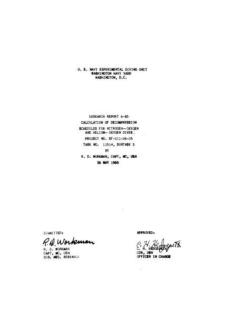

This document describes experiments made to test
assumptions underlying the conventional methods for
calculating decompression schedules:
1.
There is a critical limit to the supersaturation of a tissue
by a gas
2.
No gas is formed in the tissues of a subject who does
not develop symptoms of decompression sickness.


This document explains effects observed during
simulated diving experiments, where the subjects
have experienced intense itching, confluent
maculopapular skin lesions, and a severe vestibular
derangement with vertigo and nystagmus, when a
gas mixture containing nitrogen or neon was being
breathed while a second inert gas, helium, was
present in the surrounding environment. Thus, it
describes the effects of counterdiffusion.

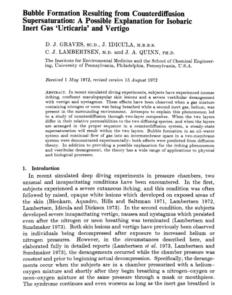

Abstract:
To gain insight into the pathogenesis of warm-water
immersion dermatoses, an experimental technique was
developed whereby skin sites on human subjects could be
continuously exposed to water for varying time periods
simulating actual expo ·ures receivedby affected patients.
Clinical and histologic observations of test sites exposed to
water for 72 to 144 hours revealed intense subacute
dermatitis. Contrary to established beliefs, the induction
and intensity of responses were not dependent upon
increases in skin surface pH or bacterial population.
Moreover, neither post hydration anhidrosis nor miliaria
were found, although stratum corneum hydration and
maceration · were pronounced.
It is proposed that either water itself or some
unrecognized potentially toxic natural surface substance is
responsible for the dermatitis.

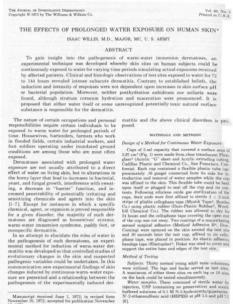

This document is a synthesis of descriptions of HPNS that
have been published in 1970 & 1971:
• Bennett and Towse 1971
• Fructus and Agarate 1971
• Fructus et al. 1971;
• Fructus and Conti 1971
• Fructus and Vigreux 1970
Doctor Bennett is a physiologist who was employed by
the royal Navy, and also headed the Defence and Civil
Institute for Environmental Medicine (DCIEM) in Canada.
He is the founder and former president of the Divers Alert
Network (DAN), a non-profit organization devoted to
assisting scuba divers.
He is also the author of numerous diving medical books,
and is a recognised diving medical expert.

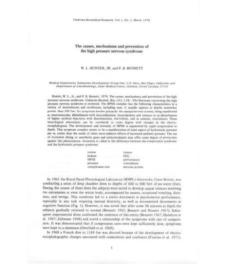

This document is a conference made by Doctor Christian
J. Lambertsen to describe the concept of isobaric
counterdiffusion and bind together elements determining
decompression safety.

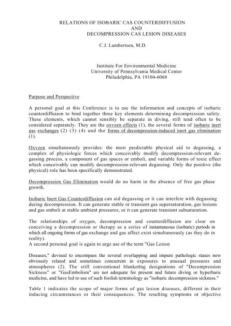

This document was published in 1966.
Brian Andrew HILLS (1940 - 2006) was a physiologist who
did fundamental researches regarding decompression
models.
He is the author of the "thermodynamic decompression
model", which is based on the concept of “unsaturation”
and in which decompression is controlled by the volume
of gas bubbles coming out of solution.
This model suggests deeper decompression stops than the
models based on Haldane's theory. It is used to design
new decompression tables.
Hills is also the author of numerous publications regarding
decompression problems.

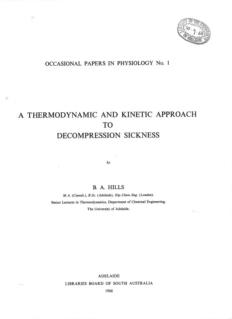

This document was published in 1968. It describes
experimentations made by exposing a symptom-free
individual with a history of retrobulbar neuritis to 2.0
atmospheres (atm) of inspired oxygen for six hours to
obtain transient diminution of vision.
The document explains two distinct processes that
appeared to have been involved in producing the visual
disturbance.
One was considered an acute expression of oxygen
effect on neuronal elements by direct action on enzymes
or limitation of nutrient flow.
A second process was considered to have been a
recrudescence of retrobulbar neuritis.
The authors concluded that this case emphasized the
need for a detailed evaluation of all individuals exposed
to oxygen at greater pressures than atmospheric
pressure.
Doctor Christian James Lambertsen (1917 - 2011) is
known for his works on the effects of hyperbaric oxygen
and was the 1st scientist to describe the mechanism of
counterdiffusion. He is associated with many papers
published on this website.

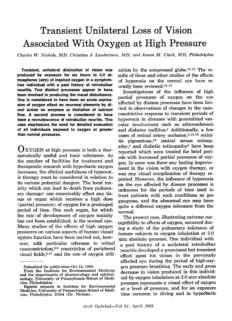
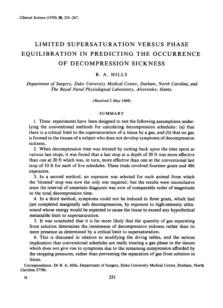

"U. S. Navy operational diving was computed for years
1958, 1960, and 1961. A comparison was made between
the incidence using the old U. S. Navy air decompression
tables (1958) and the revised U. S. Navy air
decompression tables (1960, 1961). Incidences were also
computed for dives equal to or greater than 100 feet and
less than 100 feet.

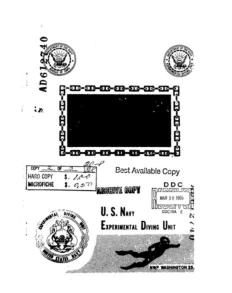

"In the present investigation of diving bradycardia in the
human subject, the cardiovascular responses to breath-
holding have been examined both in air and in water at
various depths of immersion. The results provide an
explanation of the mechanism of the response. A
preliminary account of this work has been presented to
the Australian Physiological Society (Harding & Roman,
1961).

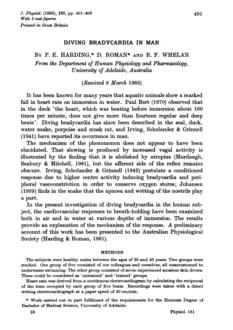

Author: Leslie A. Guildner
The values of thermal conductivities being reported in this
paper were obtained by the author at the Massachusetts
Institute of Technology. They were to have been part of a
more extensive set of measurements, but further work was
not completed with this equipment because the author
came to the National Bureau of Standards. Even though
the number of these results is small, the measurements
are thought to be sufficiently accurate to be useful.

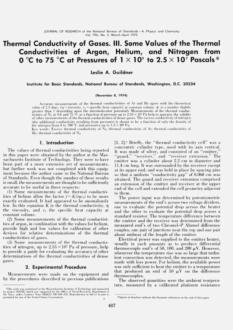

The primary purpose of this review was to examine the
evidence for pulmonary oxygen toxicity in man when
oxygen is administered at normobaric conditions or the
equivalent partial pressure. However, because of the limits
to experimental evidence in man, the effects of prolonged
administration of high concentrations of oxygen in
experimental animals and primates were also discussed,
where it was relevant to evaluating the evidence of
pulmonary oxygen toxicity in man.

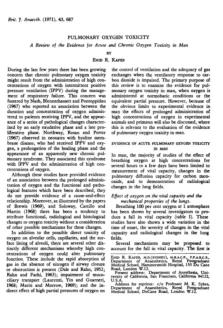

This document, published in 1971, is a description of the
various phases of a simulated dive at 458m conducted at
the Experimental Hyperbaric Centre in Marseilles with two
men from the British Royal Naval Physiological Laboratory,
aged 26 and 20 years.
A compression rate of 100 ft (30 5 m) in 6 minutes was
used and broken into stages to permit the study adaptation
and recovery to HPNS. The ascent rate was 40 ft (12 m) per
hour and was found to be too fast.
As a comparison, the ascent rate from 350 msw to 20 msw
of a modern table such as the NORMAM-15 is 50 min/msw
(1.2 m/hr), so ten times slower.

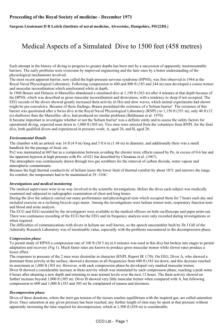

This document explains the reasons and the process
used to implement the method for calculating the
Unit Pulmonary Toxic Dose (UPTD). The tables
resulting from these calculations have been used
from this time, and still by many diving organizations
today, even though scientists such as Barbara Shykoff
and Ran Arieli have proved that this concept, done
with the scientific data available during the sixties,
has to be reviewed.
The elements from this paper are integrated into our
surface-supplied handbook to explain this concept.
Dr. Wright worked closely with Dr. Lambertsen, who
launched this concept and supported this paper.

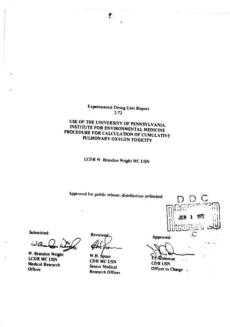

A clinical, radiological and statistical survey has been made
of decompression sickness during the construction of the
Dartford Tunnel. Over a period of two years, 1,200 men
were employed on eight-hour shifts at pressures up to 28
pounds per square inch (p.s.i.). There were 689 cases of
decompression sickness out of 122,000 compressions, an
incidence of 0-56%.

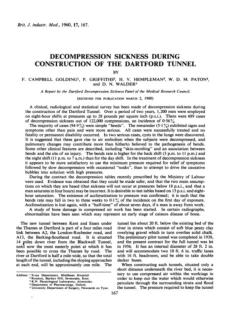

This paper is to be linked to the treatment of Acute
Oxygen Poisoning cases (Paul Bert effect).
Valium has been shown to be effective orally in the
control of chronic epilepsy, and when used parenterally,
we were pleased to find Valium remarkably effective for
treating “status epilepticus”. The authors, therefore,
decided to carry out an extensive study of its use in such
conditions.

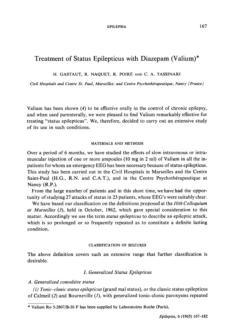

Author: Joseph C. Farmer j
This paper reports to the Undersea Medical Society the
discussions on “labyrinthine dysfunction during diving”
during a workshopheld on at Duke university medical
center (USA) in february 1973.

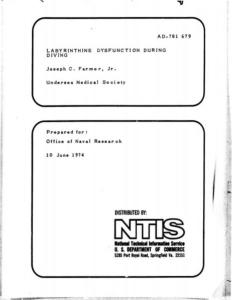

Author: Richard H. Strauss
Gelatin exposed to N2 at differing pressures was
decompressed to form bubbles findings are consistent
with the existence in gelatin of a spectrum of stable gas
nuclei which can b compressed or transformed into
bubbles. Results suggest that the number of bubbles and
their total volume can be-decreased, and decompression
time shortened, if the gas supersaturation pressure
remains constant for decompression of a given tissue.



Author:s Merill P. Spencer & David C. Johanson
This document was one of the 1st Paper on the use of
Doppler for detecting blood bubbles.

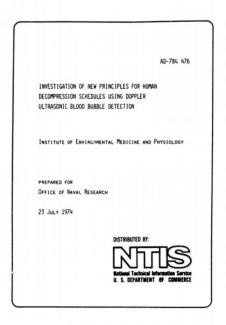

This document is the summary of a workshop held in
1976 between doctors and specialists of decompression
to share knowledge and set up bases for developing
decompression tables.

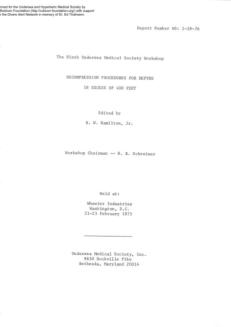

Hamilton et al. conducted experiments to see whether
neon in mixed gas was suitable. The mixture was
composed of 25% helium and 75% neon, to which
oxygen was added. The team modified classical theory to
fit existing data, mainly from their experience with helium,
to develop the decompression tables. The resulting
decompression schedules proved to be unexpectedly
troublesome, causing sensory problems and delayed
effects.

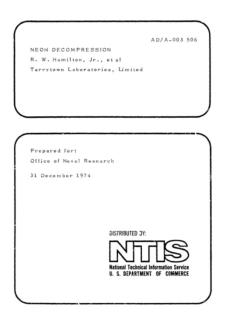



Author: P. Paulev
This document raises the question of whether
decompression sickness is unlikely for skin divers, given the
limitations in depth and duration of submersion that
prevent significant nitrogen absorption and restrict access
to compressed air supply at depth.

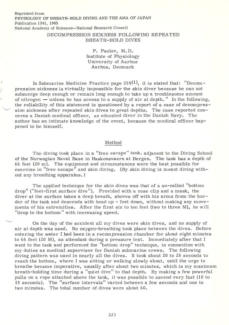

This document provides a collection of papers related to
the main topic of the DCIEM conference #73-cp960, held
in Downview, Canada, in 1973, in addition to its
proceedings.

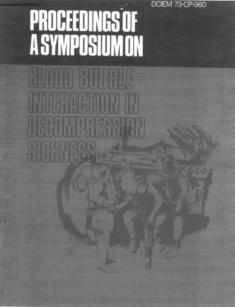

Author: James H. Dougherty
This study aims to determine whether hydrogen is a
suitable inert gas for diving to 200 feet and to investigate
the possible improvement in ventilatory performance with
this least dense of all possible breathing gas mixtures.

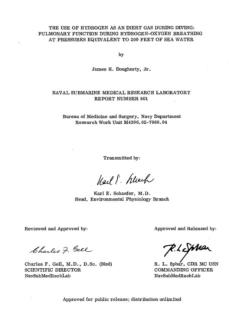



Authors: D. F. Brebner and D. McK. Kerslake
This study discusses the reduced sweat rate when
moistening skin with water or a dilute saline solution. This
effect has been observed in localized areas, such as the
palms of the hands and over the whole body. Studies by
Randall & Peiss (1957) and Hertig et al. (1961) showed
that water immersion initially increases sweat rate as body
temperature rises and then decreases over time even
when body temperature remains constant. The decrease
is thought to be due to skin contact with the water,
possibly causing swelling of epidermal cells that block
sweat ducts.

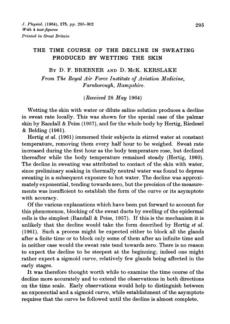

This document was published by the Academy of Sciences
of the U.S.S.R in 1964.
It examines how different gas mediums and pressures can
affect various bodily functions. The book was a collection
of research papers on this topic, published by the
Academy's Institute of Evolutionary Physiology. The work
covered the physiological effects of different gas
environments and pressures on the human body, likely
with a focus on applications in fields like aviation, diving,
and space exploration.

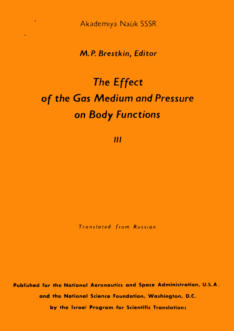

Author: P. Paulev
This document, published in 1965, suggests that the old
belief that decompression sickness is almost impossible for
breath-hold divers because they do not typically dive deep
or long enough to absorb significant amounts of nitrogen
unless they have access to an air supply at depth is
challenged by a reported case of decompression sickness.

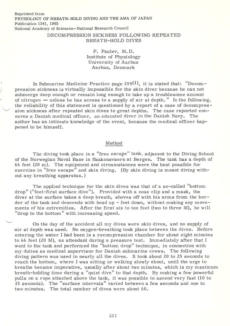

Authors: Fenton Shaffner, & Philip Felig
This study examined the livers of rats exposed to varying
pressures of pure oxygen to investigate the toxic effects on
a metabolically sensitive organ. The changes were
deemed non-specific and adaptive rather than toxic,
suggesting no permanent harmful effects on the liver
under the experimental conditions.

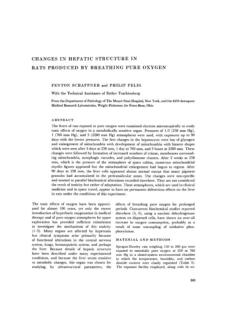

Authors: Charles E. Mengel & Herbert E. Kann
This document discusses the effects of oxygen under high
pressure (OHP) on biochemical and functional changes in
animals and humans, emphasizing the potential for
increased oxidation of compounds, such as the
peroxidation of unsaturated fatty acids. The studies
confirm the in vivo formation of lipid peroxides in mouse
erythrocytes under OHP, linking lipid peroxidation to
haemolysis under these conditions.

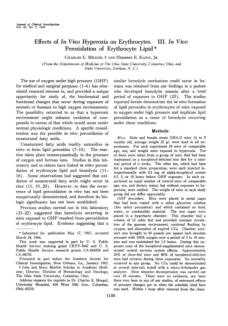

Author: Banks Anderson
This paper discusses experiments aiming to improve
oxygen delivery to the retina in patients with acute and
chronic ischemic conditions.
Understanding the effects of oxygen and carbon dioxide
concentrations on the eye is crucial for comprehending
ocular diseases. The study describes experiments
conducted over three years to study the ocular effects of
varying oxygen and carbon dioxide levels.

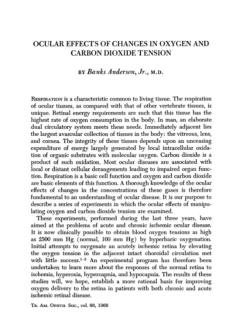

Authors: X Fructus, & J Chouteau
The Diogene project, also known as Precontinent 1,
represents a pioneering endeavor in the field of
underwater habitation and saturation diving. Conducted
in September 1962 within the Marseilles harbor, this
project was a collaborative effort between COMEX and
Commandant Cousteau's team. The primary objective was
to study the physiological and psychological effects of
saturation diving on divers residing in an underwater
habitat at a moderate depth of 10.5 meters seawater
(msw).
Note that this document is written in French



Author: R.D. Workman
The 1965 report presents the theoretical basis and
calculation methods for decompression schedules in
diving using nitrogen-oxygen and helium-oxygen
mixtures. It aims to explain the theory behind saturation
and desaturation, provide simplified calculation
procedures, and offer necessary tools such as tables and
worksheets for practical application. Additionally, it
discusses and evaluates other methods of calculation in
this field.

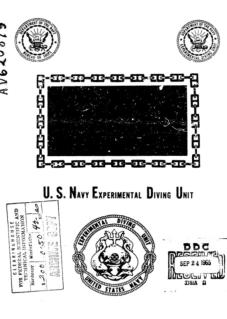

Author: J.K. Summitt
The purpose of this document was to summarize a series of
saturation dives conducted by the US Navy Experimental
Diving Unit. It outlines the objective of the dives, which was
to verify a decompression schedule for use at SEALAB III, an
underwater habitat project launched on February 15,
1969. It mentions the number of dives, divers, and the
depths reached. It also highlights the development of a safe
decompression schedule for use from a depth of 600 feet
and notes the occurrence of eight cases of decompression
illness, which are detailed in the report.

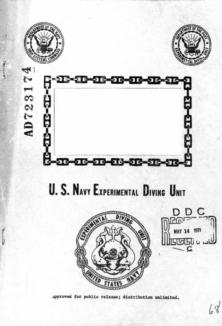

Aauthor: William R. Braithwaite
The purpose of this paper is to assist in understanding
and simplifying the calculation of decompression
schedules as presented in Workman's theoretical
framework. It clarifies definitions, explains complex
concepts, and offers a step-by-step guide to facilitate the
calculation process, while also providing methods to
reduce the time required for these calculations.
Additionally, it includes necessary tables and worksheets
to assist in the process.

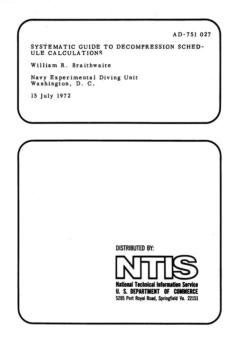

Author: Xavier Fructus
This document by Doctor Fructus describes certain
aspects of the Sagittaire II project, which took place in
February 1973. It was a significant experiment conducted
by the COMEX organization, which involved prolonged
exposure to high-pressure conditions, with divers
remaining submerged for up to 100 hours at a depths
exceeding 350 m. It explored the physiological effects of
high-pressure environments on divers and has been used
to develop procedures to enhance safety and
performance during deep dives.

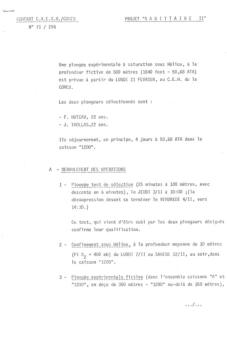


Click on the octopus
to return to the top
of the page

The January 27-29, 1970, sessions of the U. S. House of
Representatives' Committee on Science and Astronautics
focused on progress in space exploration, scientific
research, and technology. Discussions included NASA's
programs, funding for scientific projects, and the impact
of space exploration on national and global
advancement. There was also focus on improving
information use in research initiatives.


20 - NASA: Panel On Science and Technology eleventh meeting -
The management of information & knowledge
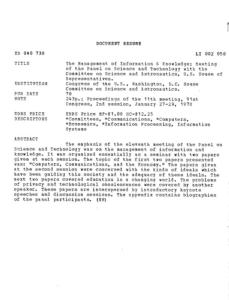
Author: W.R. Lee
This report discusses 104 electrical accidents affecting 85
men. Part I details different types of injuries such as flash
burns, Joule burns, arc eye, and electric shocks, noting
that these injuries do not correlate with voltage levels,
which range from 240/415 volts to 33 kilovolts. Flash
burns were most common on the face and hands, while
Joule burns primarily occurred at medium voltages. Part II
covers 43 incidents of electric shock, revealing that longer
exposure increased the risk of serious symptoms and
unconsciousness. Some victims unexpectedly freed
themselves without losing consciousness.


2 - A clinical study of electrical accidents
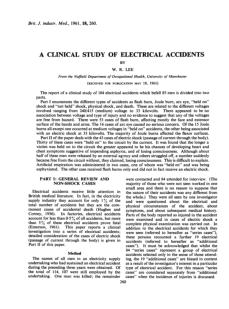

Authors: E. C. Potrtrou, A. Carpenter, M. J. Catton
This short study discusses at which pressure Nitrogen
Narcosis happens using the results of experiments on
men. It concludes that a pressure of about 2
atmospheres absolute appears to be the lowest at which
measurable changes in mental efficiency are likely to be
found.


3 - Mild Nitrogen Narcosis ?
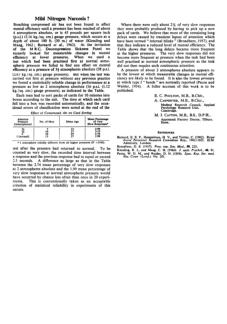

Authors: Alfred A. Bove, John M. Hallenbeck, and David
H. Elliott
During this study, plasma and red cell volumes were
measured in 12 dogs after various decompressions from
220-foot air dives. A 25- to 30-minute dive caused a limb
bend, while a 35- to 40-minute dive resulted in a spinal
cord lesion. A short dive to 70-90 feet was used to
prevent severe issues. Dogs with paretic dives lost plasma
and had elevated hematocrit, while safe dives showed
no changes. Plasma loss is important in severe
decompression sickness.


30 - Changes in blood and plasma volumes in dogs during
decompression sickness












